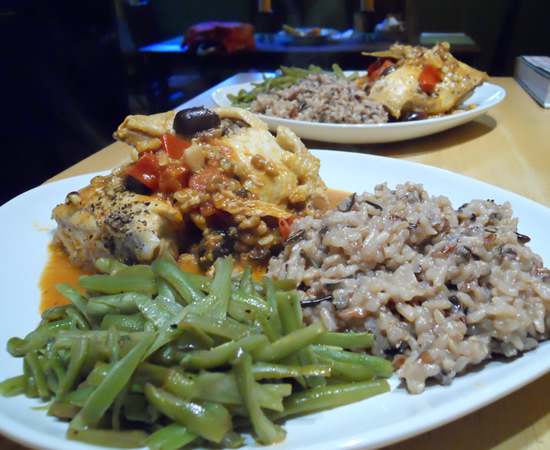Another day, another dinner. Another fun recipe from Lidia. Or, at least, based on a recipe by Lidia. I got it started, and then our Maytag Repairman showed up to fix the dishwasher. I hate people standing over me when I work, so I turned everything off and retired to the office while he did what he needed to do.
I liked the concept of her recipe and if I had been standing in the kitchen the entire time I may have made it more or less exactly how she made it, but after having it sit for 30 minutes unattended, I tweaked it a bit.
Her recipe is direct from her website:
Chicken with Olives & Pinenuts
Pollo con Olive e Pignoli
- 3½ to 4 pounds assorted cut- up chicken pieces
- 1 teaspoon kosher salt
- 2 tablespoons extra- virgin olive oil
- 2 tablespoons butter
- 3 plump garlic cloves, peeled
- 2 bay leaves, preferably fresh
- 1 cup brine- cured green Italian olives or oil- cured black Italian olives
- ½ cup white wine
- ¼ cup toasted pine nuts
Recommended equipment: A 12- inch cast- iron or other heavy skillet or sauté pan, with a cover; an olive pitter
Rinse the chicken pieces, and pat dry with paper towels. Trim off excess skin and all visible fat. Cut drumsticks off the thighs; cut breast halves into two pieces each. Season the chicken all over with the salt.
Put the olive oil and butter in the pan, and set over medium- low heat. When the butter is melted and hot, lay in the chicken pieces, skin side down, in a single layer; drop the garlic cloves and bay leaves in the spaces between them.
Cover the pan, and let the chicken cook over gentle heat, browning slowly and releasing its fat and juices. After about 10 minutes, uncover the pan, turn the pieces, and move them around the pan to cook evenly, then replace the cover. Turn again in 10 minutes or so, and continue cooking covered.
While the chicken is browning, pit the olives (if they still have pits in them). If you’re using small olives like Castelvetrano, use a pitter and keep them whole. If you have larger olives (such as Ascolane or Cerignola), smash them with the blade of a chef’s knife to remove the pits, and break them into coarse chunks.
After the chicken has cooked for 30 minutes, scatter the olives onto the pan bottom, around the chicken, and pour in the wine. Raise the heat so the liquid is bubbling, cover, and cook, gradually concentrating the juices, for about 5 minutes.
Remove the lid, and cook uncovered, evaporating the pan juices, occasionally turning the chicken pieces and olives. If there is a lot of fat in the bottom of the pan, tilt the skillet and spoon off the fat from one side.Scatter the pine nuts around the chicken, and continue cooking uncovered, turning the chicken over gently until the pan juices thicken and coat the meat like a glaze.
Turn off the heat, and serve the chicken right from the skillet, or heap the pieces on a platter or in a shallow serving bowl. Spoon out any sauce and pine nuts left in the pan, and drizzle over the chicken.
What I didn’t get was a browned chicken. It was more steamed. Not a bad thing, per se, but it looked a little pale. So… I had a few baby roma tomatoes that I tossed in, along with a shot of tomato paste. I used kalamata olives instead of the green Italian olives Lidia suggested and since the pine nuts on the shelf had seen better days, I tossed in some walnuts.
Worked great.
I added a bit of shredded cheese to the rice for just a bit of creaminess and a splash of balsamic vinegar on the green beans to pretend they were Italian.
Later on, I’ll see about having a small scoop of ice cream.
1 Comment
Add comment
This site uses Akismet to reduce spam. Learn how your comment data is processed.


Uncle Tobys Honey Lemonade Recipe: 1/2 gallon warm water, 1/2 cup honey, 1/4 cup sugar, 1/2 cup fresh lemon juice. Just mix it all with your hands (their warmth will disolve the honey and sugar) and pour mixture into a gallon container filled 3/4 with ice. Try some exotic styles of honey for a little extra spice.